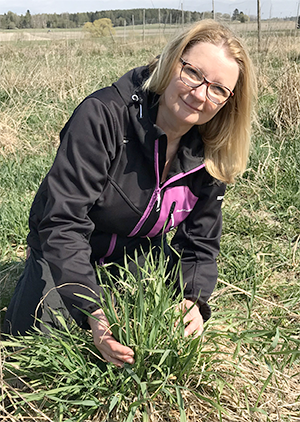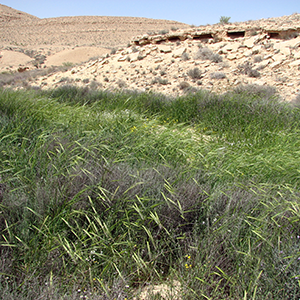Contact
 Anna Westerbergh
Anna Westerbergh
Associated Professor
Department of Plant Biology, SLU
E-mail: anna.westerbergh@slu.se
Telephone: +46 (0)18-67 33 40
CV-page

Wild relatives of crops are adapted to a wide range of habitats and stresses. Much of the phenotypic and genetic diversity of the wild populations was, however, lost as a result of the human and natural selection during domestication. The wild relatives are therefore potential sources of traits and alleles for improvement of tolerance to biotic and abiotic stresses in cereals. We are studying the adaptation of biotic and abiotic stresses in wild relatives of barley and wheat.
H. spontanum grows in a variety of habitats throughout its distribution range from the Mediterranean shore to Central Asia. These habitats are located at different altitudes and have large variation in precipitation and temperature. The adaptation to a wide range of habitats and stresses makes H. spontaneum a potential donor of traits and genes for tolerance to abiotic stresses.
We have characterized the genetic variation in wild populations of H. spontaneum using DNA sequencing and population genetic methods. In addition, gene expression of barely genotypes differing in tolerance to drought was analyzed to identify candidate genes controlling this trait. By applying genome-wide targeted enrichment sequencing and targeted resequencing of important genes for adaptation, we identified novel diversity in wild barley.
This research was carried out in collaboration with my former PhD student Girma Bedada and in close collaboration with Karl Schmid at the University of Hohenheim, Germany.
Waterlogging in agricultural fields is projected to increase in northern Europe due to climate change. We have evaluated the response to waterlogging stress in H. spontaneum accessions from different geographical areas with high precipitation as well as a set of cultivars, and have identified waterlogging tolerant genotypes. Based on the large variation found in tolerance, we distinguished suitable parents for generating mapping populations for quantitative trait loci analysis, and genotypes for gene expression studies.
Collaborators in this research are Per-Olof Lundquist, Mohammad Sameri and Girma Bedada at our department.
Funding: The Swedish Research Council Formas, Nilsson-Ehle Endowments
Infections of Wheat dwarf virus (WDV), transmitted by the leafhopper Psammotettix alienus, has periodically led to extensive damage of wheat in Sweden and other parts of Europe. Although some variation in susceptibility occurs among wheat cultivars, there are no known resistant cultivars.
We evaluated eighteen wild and domesticated wheat taxa with different ploidy levels and genome types, directly or indirectly involved in wheat evolution, for traits associated with WDV disease such as leaf chlorosis, different growth traits and WDV content. We found a large variation in response to WDV among wild wheat relatives, ranging from highly susceptible genotypes to genotypes showing tolerance and recovery during growth. Further studies are carried out to investigate the variation in response within taxa.
Collaboration: This research is done in collaboration with the former PhD student Jim Nygren supervised by me and in collaboration with Anders Kvarnheden at our department.
Funding: The Swedish Research Council Formas and the Royal Swedish Academy of Agriculture and Forestry
 Anna Westerbergh
Anna WesterberghAssociated Professor
Department of Plant Biology, SLU
E-mail: anna.westerbergh@slu.se
Telephone: +46 (0)18-67 33 40
CV-page
Nygren J, Shad N, Kvarnheden A, Westerbergh, A. 2015. Variation in susceptibility to Wheat dwarf virus among wild and domesticated wheat. PLoS ONE 10: 1-24, doi: 10.1371/journal.pone.0121580
Sriskandarajah S, Sameri M, Lerceteau-Köhler E, Westerbergh A. 2015. Increased recovery of green doubled haploid plants from barley anther culture. Crop Science 55: 2806-2812 doi: 10.2135/cropsci2015.04.0245
Bedada G, Westerbergh A, Mueller T, Galkin E, Bdolach E, Moshelion M, Fridman E, Schmid KJ. 2014. Transcriptome sequencing of two wild barley (Hordeum spontaneum L.) ecotypes differentially adapted to drought stress reveals ecotype-specific transcripts. BMC Genomics 15:995-1013, doi: 10.1186/1471-2164-15-995
Bedada G, Westerbergh A, Nevo E, Korol A, Schmid KJ. 2014. DNA sequence variation of wild barley Hordeum spontaneum (L.) across environmental gradients in Israel. Heredity 112: 646-655, doi: 10.1038/hdy.2014.2
”Jordbruket anpassar sig till nytt klimat”, Vetandets värld - radio program in Swedish.